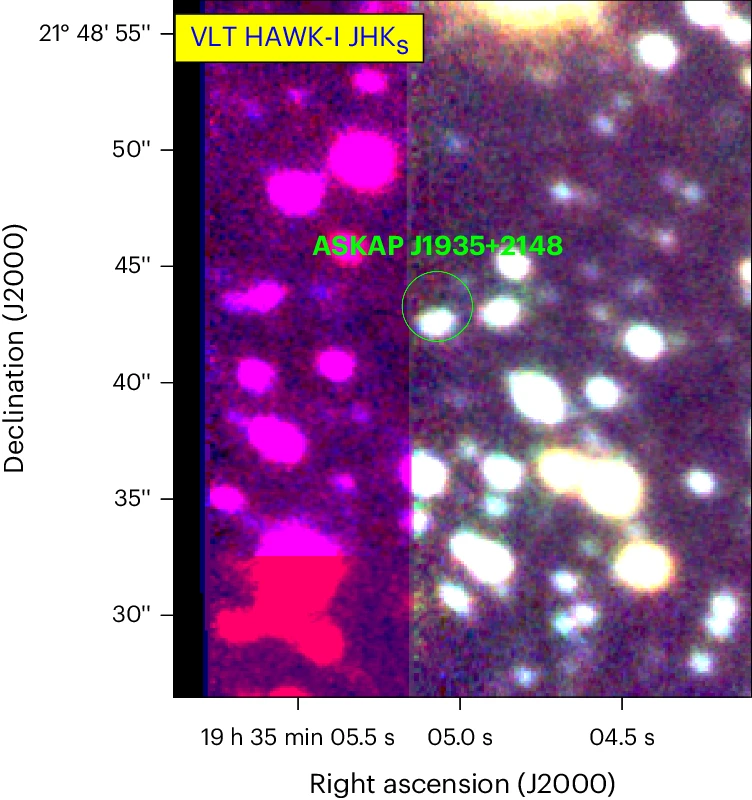In the vastness of the universe, astronomers continuously discover phenomena that challenge our understanding of the cosmos. One such recent discovery is ASKAP J1935+2148, a radio transient that defies conventional expectations. Detected with a cycle lasting almost 54 minutes, this finding is a groundbreaking puzzle for astronomers, offering insights into the complexities of neutron stars and white dwarfs.
What is ASKAP J1935+2148?
ASKAP J1935+2148 is not your typical radio transient. Unlike other sources that pulse rapidly, sometimes within milliseconds, ASKAP J1935+2148 follows a slow, nearly hour-long cycle. This makes it the longest-known radio transient. The object might be a unique neutron star or a white dwarf, which makes it especially intriguing.
This slow-spinning nature is unusual. Typically, neutron stars, which are remnants of supernova explosions, spin rapidly, emitting radio waves that sweep across space like cosmic lighthouses. Yet ASKAP J1935+2148 challenges this notion, suggesting there might be new, unexplored states of such celestial bodies.
Discovery and Observations
The discovery of ASKAP J1935+2148 was made possible by CSIRO’s ASKAP radio telescope in Western Australia. With its ability to monitor vast portions of the sky simultaneously, ASKAP spotted the periodic flashes from ASKAP J1935+2148. This telescope’s capability to detect circularly polarized radio waves allowed it to filter out common radio sources, revealing the peculiar object.

After the initial detection, follow-up observations were conducted using the more sensitive MeerKAT telescope in South Africa. These observations spanned several months and allowed researchers to confirm the unique characteristics of ASKAP J1935+2148. Its detection is a testament to the advancements in radio astronomy that allow scientists to observe even the faintest cosmic signals.
Why This Discovery is Unique
ASKAP J1935+2148 stands out in the field of radio astronomy for several reasons. Its nearly 54-minute cycle is unprecedented among known radio transients. Typically, neutron stars emit pulses in fractions of a second, making this discovery an outlier. The object’s emissions varied, appearing in three distinct states: bright, weak, and quiet. This behavior indicates complex interactions within the object, possibly involving magnetic fields and plasma dynamics.
These features have not been observed in other long-period radio transients, making ASKAP J1935+2148 a fascinating subject for further study. Understanding these unique characteristics could provide a new perspective on how such objects evolve and interact with their surroundings, pushing the boundaries of existing astrophysical models.
Possible Explanations and Theories
One of the most plausible explanations for ASKAP J1935+2148 is that it is a slow-spinning neutron star, yet this hypothesis comes with challenges. Traditionally, neutron stars spin rapidly because of their high angular momentum. The existence of a neutron star with such a slow rotation suggests that it may have evolved differently or experienced external influences that slowed its spin.
Alternatively, some astronomers speculate that ASKAP J1935+2148 could be a white dwarf—the remnants of a star that has burned through its fuel. White dwarfs are known to have slower spin rates, but they typically do not produce the radio emissions observed here. This raises the possibility that ASKAP J1935+2148 is part of a binary system, where interactions with a companion star could produce the observed emissions.
Both scenarios challenge our current understanding of these celestial objects. If ASKAP J1935+2148 is a neutron star, it may require new theories about how such objects evolve. If it’s a white dwarf, it suggests a previously unknown mechanism by which these stars can emit radio pulses, offering new directions for research.
Implications for Future Research
The discovery of ASKAP J1935+2148 opens new avenues for exploring long-period radio transients. It suggests that there could be other similar objects in the Milky Way, waiting to be detected. Future studies with next-generation radio telescopes like the Square Kilometre Array (SKA) could uncover more such anomalies, helping to refine our models of neutron stars and white dwarfs.
Additionally, ASKAP J1935+2148 could provide insights into the behavior of magnetic fields in extreme environments. Its varying emission states hint at dynamic interactions between magnetic fields and plasma flows. Studying these interactions could shed light on broader phenomena, such as how magnetic fields shape the behavior of pulsars and fast radio bursts.
The implications extend beyond radio astronomy. Understanding ASKAP J1935+2148 can inform theories about the end stages of stellar evolution, revealing how massive stars transition into neutron stars or white dwarfs. It might also help astronomers identify similar objects in other galaxies, providing a new lens through which to view the universe.
Conclusion
ASKAP J1935+2148 is a reminder that the cosmos is full of surprises. Its discovery challenges astronomers to rethink their understanding of neutron stars, white dwarfs, and the nature of radio transients. As we continue to explore the universe, objects like ASKAP J1935+2148 offer a window into the unknown, reminding us that even in the vast expanses of space, there is always more to learn and discover.
This newfound cosmic enigma not only enriches our understanding of stellar evolution but also underscores the importance of advanced observational technology in unveiling the universe’s secrets.
Reference:
Caleb, M., Lenc, E., & the ASKAP Collaboration. (2024). Discovery of ASKAP J1935+2148: A Long-Period Radio Transient.



















